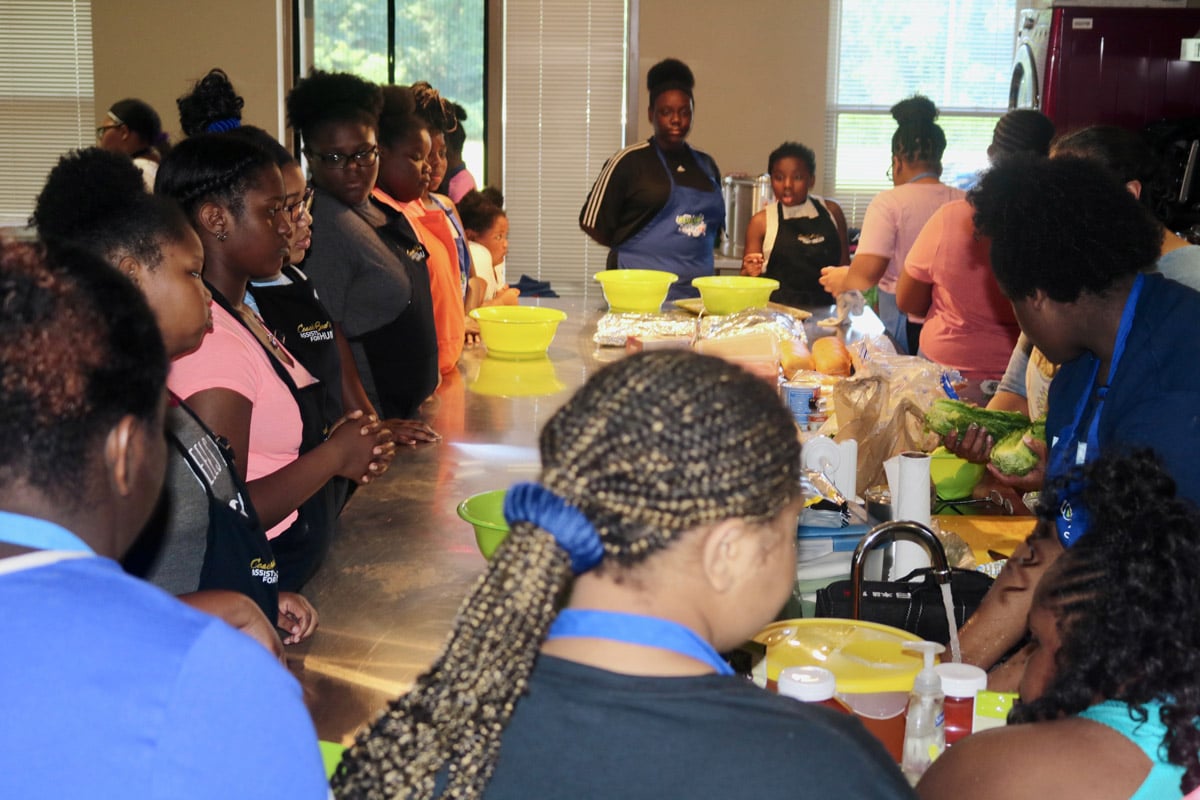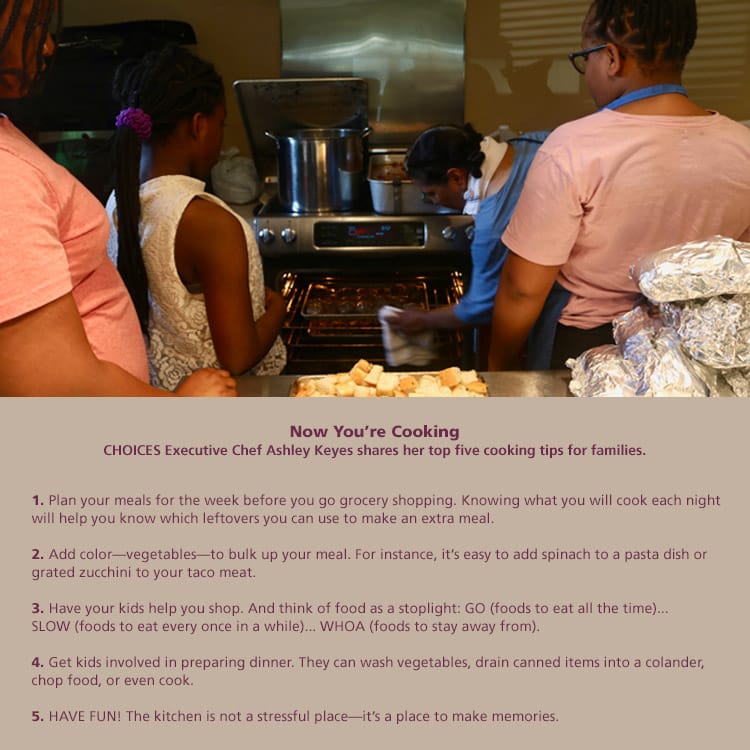Fulton County Families Learn to Cook Together with CHOICES

by Krystin Dean
“There’s no way my child is going to eat that.”
Parents often utter these words when they walk into the teaching kitchen at the Oak Hill Child, Adolescent and Family Center and see a big bowl filled with vegetables—some of which their child has never seen, let alone tasted.
The free “Cooking with CHOICES” program at Oak Hill, a 22-acre campus that provides coordinated care to Fulton County’s children and families, primarily serves low-income families where a child or parent is experiencing obesity, diabetes, hypertension, asthma, or heart disease. Participants learn to cook healthy meals on a budget with Executive Chef Ashley Keyes and culinary student volunteers.
“When children help cook a meal and then clean their plates, it’s a real eye-opener for the parents,” said Vanetta Keyes, the healthy cooking and nutrition education lead for CHOICES (Center Helping Obesity in Children End Successfully). “They see the kids trying different things, and then the parents will go home and attempt to replicate the experience with their children.”
One in four children live in poverty in this area of Fulton County, which is saturated with retail shops, abandoned buildings, and fast-food chains. Residents have limited access to affordable, nutritious meals—making it easy to stop at the drive-through instead of cooking at home.
“We always emphasize to families that food plays a role in how effectively a child will succeed in school,” said Janet Adams, coordinator for Atlanta Fulton Family Connection. “We’re bringing in partners who are looking at social determinants of health and well-being, because you can’t provide a nutritious meal if you don’t have money to buy the food.”
The Fulton County Collaborative partners are looking to shift the mindset of nutrition from a conscious effort to one of culture—and that involves bringing families and the community closer together.
“If we can get families in our kitchen and then continue to do what we have taught them at home and share it with others, it becomes more of a culture of making healthier habits,” said CHOICES Program Director Kenya Heard. “We want families to do these things as part of their normal, everyday routine. We want it to come so easy to live healthier that they don’t even think about it.”

Atlanta Fulton Family Connection and 11 other Georgia Family Connection Early Childhood Health and Education (EC-HEED) cohort Collaboratives are working to decrease childhood obesity, improve child health, and increase the percentage of children reading proficiently by third grade. Fulton County’s EC-HEED strategy team established three priorities when it formed in 2015:
- providing a summer reading program for children ages 4 – 9,
- implementing the Cooking with CHOICES classes, and
- establishing a community garden.
The cohort’s partner base—which includes Fulton County Schools, Atlanta Public Schools, CHOICES, Atlanta Food Bank, WIC, Wellcare, Peach State, Families First, Lighthouse Tutoring, Atlanta Fulton Library, New Calvary Missionary Baptist Church, Helping Mamas, Reach Out and Read, and Amerigroup—also work together to recruit participants and offer family-oriented events and programs like resource fairs and parent workshops.
“Part of what we’re charged with is getting the word out, so families understand why they need these services,” said Adams. “We always want to meet people where they are, and we want them to connect with partners who care. The best way to engage families is to engage other partners who already are engaging families. We’re trying to break down the barriers so everybody can work together. There’s a greater bond between the partners now—and we’ve become more effective.”
Partners are encouraged to make connections between the cohort’s goals. For instance, the CHOICES team understands the importance of improving reading proficiency—so they make sure kids read recipes out loud during cooking class.
“Reading in front of their parents and other children helps build their character and self-esteem,” said Heard. “Even if they’re struggling, no one is judging them. People are encouraging and applauding them.”
Participants receive intensive nutrition education from a dietician who utilizes the We Can! (Ways to Enhance Children’s Activity and Nutrition) curriculum, and a new community garden on the Oak Hill campus gives kids hands-on experience while emphasizing the need to eat healthy, fresh vegetables.

“We want to expose families to positive learning climates because that’s what will help them to remember what they learned—and that’s what will change their lives,” said Adams.
Participants often become dedicated volunteers, like Kelvin and Shawnika Clemmons who signed up for Cooking with CHOICES with their daughters, Kayci, 14, and Asattah, 7, last summer.
“It’s been a fun adventure for me,” said Kelvin, who was the only dad in the room. “You’re having fun and learning at the same time. Before we participated in the classes it was mostly their mom cooking. I help out more in the kitchen now. There are still some things to learn—but I definitely do more.”
The children also help out at home, chopping vegetables and using appliances like the electric skillet with confidence. This is especially significant for Kayci, who has limited mobility on one side of her body and previously needed extra assistance with meal preparation.
“I used to heat and pour her water to make oatmeal in the morning. I’m not doing that anymore. She’s helping me cook,” said Shawnika, who credited Chef Ashley with enforcing the idea that everyone has a part to play in the kitchen.
“The classes bring you together as a family to accomplish a task. And most of the time we don’t have that at home. Mom’s in the kitchen preparing everything, and then everyone else comes and makes their plate,” Shawnika said. “Chef is not going to let one person sit down while everybody else does the work. So, when you go home, you do the same thing.”
Kayci will pursue a culinary arts program in high school next year, and she gets plenty of preparation at home where Asattah sets up stations in the kitchen to help everyone remember their roles as they cook at least two new meals each week.

The ingredients the Clemmons use also have evolved since the family attended one of the grocery-store tours that CHOICES leads. Asattah knows to check how much sugar is in items—and why she has to put them back if there’s too much.
“We know what we need to look for in order to eat healthy,” said Shawnika. “Now we automatically start at the vegetables and then walk the perimeter of the store. This has opened us up to a world of different foods. We’re taking chances to up our food game.”
Fresh produce is available to Cooking with CHOICES participants thanks to a partnership with the Atlanta Food Bank, which allows families to shop for food to take home, including items they may not have tried before—like butternut squash, which Chef Ashley sent home as a “mystery item.”
“We told them to find out what it is, use it in a dish, and post a picture on social media,” said Ashley, who encourages families to text or call her with questions. “We like to see progress and that what we’re teaching them is being adapted to their home life.”
Past participants celebrate strides they’re making during weekend reunion cook-off sessions hosted by CHOICES. Survey data shows that 98 percent of parents say they eat less fast food, and 90 percent of children can prepare something on their own to eat with fruit.
The EC-HEED cohort hopes to expand the cooking classes beyond Oak Hill to after-school programs where parents can cook and eat dinner with their children and then focus on homework at home. The food bank is organizing food giveaway events at local schools, and one of the Collaborative’s grants provides schools with a small budget for parent engagement events like cooking demonstrations.

“You can’t always reach parents at Oak Hill because some of them don’t have cars and some have young children,” said Adams. “We want to make sure we’re accessible, and we want to get to a place where parents are comfortable and want to come to school. The system has changed. I’ve seen it. School is becoming what it once was—a place where you go for help.”
Adams gets fresh ideas for the future by meeting with partners outside of the cohort team who are doing similar work to discuss what’s successful and what improvements they can make.
“You get more power, more strength, more ability to do this work when you engage other partners and share your knowledge and time. There is strength in numbers,” said Adams. “It’s just like lighting a flame and trying to make sure that you start a fire that spreads all over different communities so that everybody will be enlightened and understand the importance of education and what it means to children and their families.”
Cooking with CHOICES class participants receive up to eight recipes in the course of the three-week class. Here is one of the Clemmons family’s favorite recipes from Deliciously Healthy Family Meals:

